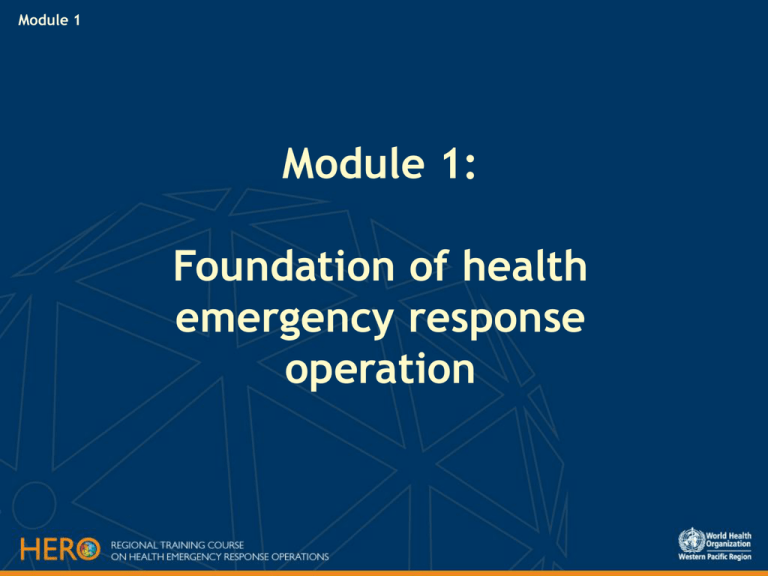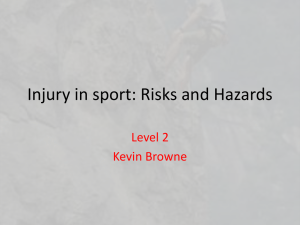
Module 1
Module 1:
Foundation of health
emergency response
operation
Module 1
Module description
This module introduces the key concepts, principles and
frameworks of emergency management system, which serves
as the foundation of health emergency response operation.
It covers the functional and organizational elements of
Emergency Operation Center
It discusses the organizations, significant systems (ex.
Coordination), resources and partners.
Describes how the functional elements of emergency
management work together to produce a coherent,
appropriately scaled response
Module 1
Module Objectives
At end of this module the participants will be able to:
Relate ERO in the overall Emergency Management Framework
Describe Emergency Response Operation
Discuss the elements of Emergency Operation Center
Apply the principles of an EOC ; and
Develop a plan to improve coordination in their own setting
Module 1
Module Content:
1.
Emergency Management Framework
2.
Health Emergency Response
3.
Emergency Operation Center and Health
Operation Center
4.
Coordination and Interoperability at different levels
Emergency
Module 1
Session 1: Emergency Management
Framework
Session Objective:
At the end of the session, participants shall be able to describe
Emergency Management Framework and Health Emergency
Response Operation
Module 1
Q&A
Give 3 examples of the following terms:
Hazard
Risk
Vulnerability
Emergency
Disaster
Community
Capacity
Module 1
A Logical Framework of Terminology
Hazard
Any potential threat to public safety and/or
public health
Module 1
Types of hazards
1.
2.
3.
4.
Natural hazards
Examples: typhoons, flood, earthquake, volcanic
eruptions, tsunami, drought
Technological hazards
Examples: fire, chemical spill, industrial
incidents, transportation accidents, radio-nuclear
incidents
Biological hazards
Examples: disease outbreaks, Red Tide
Phenomenon, Food poisoning, etc
Societal hazards
Examples: Rallies, war, armed conflict, Stampede
Module 1
A Logical Framework of Terminology
Risk
Anticipated consequences of specific hazard interacting
with specific community (at specific time)
COMMUNITY
Hazard
(Vulnerable)
RISKS
People
Property
Services Capacity
Environment
Livelihood
Emergency
Disaster
“Risk Management”
Module 1
A Logical Framework of Terminology
Vulnerabilities
Factors which increase the risks arising from
specific hazard in specific community
Determinants of risks
COMMUNITY
Hazard
(Vulnerable)
People
Property
Services
Environment
Livelihood
RISKS
Capacity
Emergency
Disaster
Module 1
“Vulnerable Groups”
• Those who because of constraints of an economic,
social, ethnic, biological, physical or geographical nature,
are less able to cope with the impact of hazards than
other members of their community or society
• Vulnerabilities are:
– Intrinsic - specific to the individual - age, sex, health
status, mobility, literacy, habits, behaviour etc
– Extrinsic - shared by groups within a community location, environment, poverty, availability of services,
culture etc.
Module 1
A Logical Framework of Terminology
Community
is a legally constituted administrative
local
government unit of a country
Module 1
Elements of the community
exposed to hazards
services
property
people
livelihoods
Community
environment
Module 1
A Logical Framework of Terminology
Capacities
Hazard
are determinants of risk
An assessment of ability to manage an
emergency (risk modifier) – total capacity
is measured as readiness
COMMUNITY
RISKS
(Vulnerable)
People
Property
Services
Environment
Livelihood
People
Property
Services
EnvironmentCapacity
Livelihood
Emergency
Disaster
Module 1
Examples of Capacities
Laws, policies, plans, procedures
Trained personnel; knowledge, skills and attitudes
Code alert systems
Institutional arrangements
Management structures
Facilities, material resources
“Risk Management”
Module 1
Ten key elements of preparedness
• Legal Framework
Policies
Procedures
Guidelines
Plans
Resources
Authority
National, provincial, local, agency and
institutional level
Knowledge
Skills
Awareness
Personal and
community level
Module 1
A Logical Framework of Terminology
Emergency
An actual threat to public safety and/or
public
health
Module 1
A Logical Framework of Terminology
Disaster
Any actual threat to public safety and/or
public health where local government and
the
emergency services are unable to meet
the
immediate needs of the community
Module 1
Emergency
An exceptional event of any magnitude that produces
damage and injury and potentially exceeds the capacity of
normal resources to cope
Effects ranging from localized incidents with limited
consequences to wide area disasters with catastrophic
consequences
Often referred to as incidents or events, with the terms used
interchangeably
Module 1
Emergency Management
Comprehensive strategy of building, utilizing and restoring
capacities employed in addressing the actual threat to
public health and safety
A discipline dealing with the assessment, reduction and
avoidance of excessive risk;
It is sometimes referred to as disaster management
Module 1
Emergency Management
Organization and management of resources and
responsibilities for dealing with all aspects of emergencies,
in particularly preparedness, response and rehabilitation
Module 1
Emergency Management
It involves plans, structures and arrangements established to
engage the normal endeavors of government, voluntary and
private agencies in a comprehensive and coordinated way to
respond to the whole spectrum of emergency needs.
Module 1
Exercise 1
Describe your roles as Health Emergency Manager?
Roles
Difficulties met in past response activities
Module 1
Emergency Management Framework
Disaster Impact
Response
Preparedness
Recovery
Mitigation
Prevention
Module 1
Successful Emergency Management
System
Focus decisions and resources on priority objectives
Support sustained, high levels of collaboration and
communication
Provide systemic accountability mechanisms
Designed to address a number of principles
Module 1
Emergency management systems
Principles
Based on an all-hazard approach
Modular, scalable or adaptable organization
Support for joint engagement of multiple organizations in
management decisions
Clear lines of accountability
Clearly defined roles and responsibilities
Clear procedures for activation, escalation, and
demobilization of emergency capacities
Module 1
Emergency management systems
Principles
Common functional groupings and consistent terminology
Integrated with stakeholder agencies
Mechanisms involving all stakeholders and users of EOC in its
design, operational planning and evaluation
Provision of capacity to manage public communications
opportunities as part of the response to emergencies
Module 1
Risk Management
is a comprehensive strategy for reducing
threats and consequences to public health and
safety of communities by:
preventing exposure to hazards
(target = hazards)
reducing vulnerabilities
(target group = community)
developing response and recovery
capacities
(target group = response agencies)
Module 1
Risk Management
In Risk Management, the primary concern is to manage the
risks.
The manager has to identify the possible risks that can result
if a hazard interacts with a community, and efforts must be
directed towards building community capacities to manage
these risks.
Module 1
Risk Management Framework
Hazard
Vulnerable
Community
Risks
Capacity
Emergency
Disaster
Module 1
Relationship of Risk Management Terms
RISK = HAZARD x VULNERABILITY
CAPACITY
Module 1
Non-Disaster
Emergency
Hazard
Technological
Biological
Natural
Societal
+
Community
People
Property
Services
Livelihood
Environment
Local capacities can cope
Threat to
Public
Safety
Surge in demand
Local services intact
Services may or may not be
sufficient
Disaster Emergency
International, national, and
local response needed
Surge in Demand
Local services cannot function
normally
Resources damaged, destroyed,
inadequate or insufficient
Module 1
Risks and vulnerabilities are specific to
the five elements of the community
Hazard: Earthquake
Elements of the
community
1. People
Risks
Vulnerabilities
Deaths
2. Properties
Collapsed structure
3 Environment
Water pollution
Untrained staff on
BLS/ACLS
Hospital located on a
fault line
Poor waste
management
4. Services
Disrupted OR
services
Loss of income
5. Livelihood
No back up electrical
power
No alternative job
Module 1
Risk Management
Hazard
Vulnerable
Hospital
Environment
Natural
Technological
Biological
Societal
Poor Access to
safe water
Poor Access to
sanitation
Emergency
Disaster
Risks
Environment
Diarrhea
outbreak
Death
(ERO)
Capacity
Module 1
Risks Assessment Process
Prepares
hazard
profiles
Maps the
distribution
of those
hazards
Identifies the
elements of
the
community
exposed to
those
hazards
Predicts the
consequences
of a hazard
interacting
with that
community at
a certain time
(e.g. in a
certain
season)
Module 1
Risks Assessment Process
Analyses each of
the 5 elements of
community in
terms of that
hazard to identify
the factors which
will lead to each
consequence i.e.
determines the
vulnerabilities of
each element
Assesses risk
reduction capacities
within communities
Module 1
Risks Management Process
Risk
assessme
nt and
analysis
Hospital Emergency Awareness
and Response Training ‘09
Risk
communi
cation
Risk
reduction
“Risk Management”
Risk
monitorin
g
Module 1
Risks Reduction
The purpose of a risks analysis is to guide communities in
planning for community risks reduction activities
(protecting health and safety) by developing and
maintaining 3 sets of plans:
Hazard Reduction Plans (reduce
exposure)
Vulnerability Reduction Plans (reduce
consequences)
Emergency Preparedness Plans (increase
capacity for response and recovery)
“Risk Management”
Module 1
Emergency Response Operation
Measures undertaken in responding to emergencies
Includes operationalization of appropriate systems and
procedures emergencies
Emergency Response Operation involves
responsibilities
management structures
resource and information management
SOPs
ERO focus on protecting life, property, essential services
delivery and the environment
Module 1
Exercise
In the first week of operations for emergency
response, what are the priority activities you have to
organize as a health emergency manager?
Activities/Areas of Work
Requirements to undertake activity
Module 1
Synthesis of the Session:
Demonstration and Return Demonstration of the seven terms
of Risk Management.
Module 1
“All disasters are
emergencies but not all
emergencies are disasters”
Module 1
Session 1: Emergency Management
Framework
Session Objective:
At the end of the session, participants shall be able to describe
Emergency Management Framework and Health Emergency
Response Operation
Module 1
THANK YOU!







